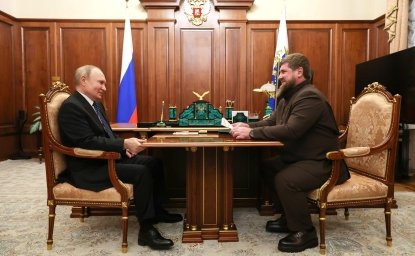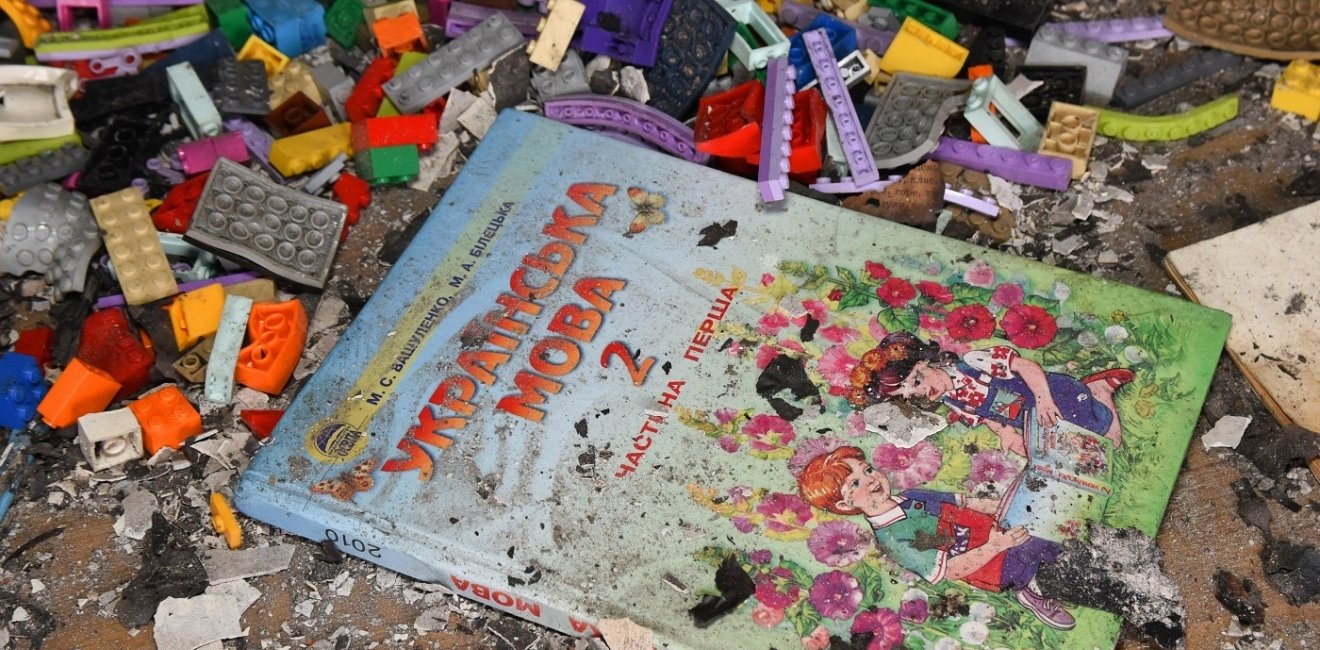
A blog of the Kennan Institute
Russia’s unprovoked war against Ukraine and the “collective West” started neither in 2022 nor in 2014, with the Russian annexation of Crimea. Today’s Ukraine is another bloody arena of Russia’s centuries-long attempt at the geopolitical, ideological, and informational conquest of its neighbors. The war against Ukraine, the 2014 annexation of Crimea, the 2014–2022 war in the Donbas, the 2008 war against Georgia, and the 1999 and 1994 Chechen wars are only the most recent examples of this drive.
For this expansionist drive to proceed, controlling the narrative about the self and the other is essential. From the Russian perspective, the country’s numerous neighbors have two options in the world arena. The first is total geopolitical and cultural submission and unconditional loyalty to Mother Russia and the hegemony of the Russian world. This approach worked for the Kremlin during the Soviet era, when all fifteen Soviet socialist republics were referred to as “sisters” within the Soviet superpower. Nationally and internationally, “Soviet” and “Russian" were used almost interchangeably.
Following the disintegration of the USSR in 1991, the former “sisters” that dared break away from Moscow, craving democratic freedoms, experiencing pro-Western ambitions, or simply pursuing a path of their own, turned into enemies and suspected traitors. This was when the second option came into play. Those disloyal rebels had to be ready to be treated as undeserving, culturally inferior, hostile and dangerous others.
Rhetorically, the freshly minted enemy quickly became subject to cultural othering, the reliable modus operandi of the tireless Kremlin propaganda machine. The old formulas, rooted deeply in Russian history, were revived: the liberator, the moral light of the world, the misunderstood martyr was again fighting the “evil, traitorous other,” the criminal, the immoral, the enemy. Russia’s war in Ukraine today, conducted in parallel with the grotesque yet explainable renaissance of Russian nationalism, is a direct outcome of successfully implemented cultural othering as a form of “equipment for living” in the globalizing world.
The Power and Paradox of Cultural Othering
Cultural othering is multifaceted and omnipresent. Paradoxically, as I demonstrate in my book, Communicating the Other across Cultures, cultural othering is simultaneously timeless and time-sensitive, universal and culturally specific. Cultural othering can lead to atrocities such as Native Americans being expelled from their homelands on the Trail of Tears, millions of Ukrainians starving to death during the Holodomor (Stalinist human-caused famine), or millions of Jews exterminated during the Holocaust.
One of the most typical features of cultural othering is its axiom-like status. It is presented as something that has been forever present in all domains of life and communication—verbal, visual, and material. It is present in songs and folklore, in the films and media we watch, in the museums and memorials we visit, in the messages and memes we share on social media.
But history and ideology do not just randomly happen—they are discursively created and communicated, time and again, to support some power structures at the cost of others. Masters did not just conquer lands and people; they also conquered, formed, and controlled the discourse about those lands and those people, and justified genocides and enslavement. Histories of the masters, with a capital H, are repeated and set in stone, while histories of the others are erased or distorted.
The impact of cultural othering is flabbergasting. The perpetrators (invaders, colonizers, and genocidal tyrants) present themselves as liberators, educators, peacemakers, and restorers of the right world order. Case in point: in November 2021 Russian president Vladimir Putin symbolically reset the history of Crimea in stone (and metal) when he inaugurated the memorial complex in Crimean Sevastopol dedicated to the end of the Russian Civil War.
Standing next to the majestic construction symbolizing Mother Russia in the form of a gilded goddess, elevated above the once belligerent parties, Putin reiterated the importance of Crimean “reunification” with the rest of the federal republic. “We are a single people, and we have only one Russia.… It is because of that unity that the people of Russia have achieved remarkable heights in economics, science, technology and culture,” Putin declared. “Sevastopol and Crimea are now with Russia and will stay with it forever, because this was the expression of the sovereign, free, and uncompromising will of our entire people.”
The fact that the natives, the Crimean Tatars, victims of Russia’s systematic policies of resettlements and subject to the 1944 Stalinist genocide, were not even mentioned in his address shows how skillfully cultural othering was performed on the occupied peninsula. For millions of Russians, such a worldview comes naturally as equipment for living with the non-Russian other. It has not changed since the times of Pushkin or Tolstoy.
Cultural Othering: from Pushkin to Putin
Already in imperial Russia, the literary giants Pushkin and Tolstoy glorified Russian martyrdom and patriarchal militarism, along with cultural othering of the French, the Swedes, the Turks, the Circassians, the Crimean Tatars, the Ukrainians, the Georgians, the Moldavians. In his epic “Poltava,” Pushkin demonized Hetman Mazepa (a Ukrainian national hero), portraying him as a sexual predator and a bloodthirsty monster obsessed with starting a war with the hated Moscow and betraying Peter the Great. Another poem by Pushkin, and later Tolstoy’s novel with the same title, “The Prisoner of the Caucasus,” both demonize the Caucasus’s natives, the Circassians, as savage, bloodthirsty, exotic highlanders. Reading Pushkin and Tolstoy is mandatory in Russian schools.
In the USSR, similar cultural othering happened, first under Lenin, later under Stalin. Stalin’s leadership solidified the doctrine of Leninism by means of an impressive propaganda machine, forced Russification, groupthink, and colonial-like Sovietization. This led to the triumph of a homogenous Soviet identity over the former ethnic and class diversity. The Soviet national anthem communicated the worldview best:
Unbreakable Union of freeborn Republics,
Great Russia has welded forever to stand.
Created in struggle by will of the people,
United and mighty, our Soviet land!
The Soviet poet Mayakovsky, referring to the 1917 October Revolution, writes in “For Our Youth”: “Comrades, youths, look up to Moscow! … When the October of gun storms was bleeding through the streets, I know that in Moscow the fate of Kyiv and Tiflis was decided.” Already in 1917, Moscow had decided to Russify and Sovietize Ukraine and Georgia, brutally breaking any resistance on their part.
History also shows just how brutal the punishment for the resistance and disobedience was. Ukraine paid a horrible price: the 1923–1933 Holodomor cost the lives of millions of Ukrainians. The mighty Soviet propaganda machine silenced utterances on a Ukrainian genocide and discursively othered the Ukrainian fight for independence as a criminal and treacherous act of betrayal of the Soviet Motherland, equal in its evilness to the atrocities of Nazi Germany. Cultural othering succeeded in all discursive domains: literature, politics, education, film and media, museums, memorials.
Forward to the Past!
In 2005, Putin famously declared that the fall of the USSR was the last century’s “biggest geopolitical catastrophe.” Imperial and Soviet nostalgias, Russian martyrdom in World War II, and antifascism are central to the Russian worldview. So is cultural othering. So—another déjà vu. It is one more Russian invasion, and once more they call it “liberation,” “demilitarization,” “de-Satanization,” and “denazification.”
Using (and abusing) history and collective memory, Russia follows the same formula of cultural othering. This time, the others are Ukrainians, supported by the collective West. Ukrainians, 8 million of whom lost their lives in World War II, are now labeled “Nazis.” The message is clear: you are either the brother (in arms!) or the other.
As if the years of imperialism, Leninism, and Stalinism were not enough, Russia, having accepted and supported Putinism, has now marched into another war, driving cultural othering to the level of the absurd; into a war that, given the history of Kyivan Rus as the cradle of Russian civilization, is an ethnic fratricide and a matricide at once.
The opinions expressed in this article are those solely of the author and do not reflect the views of the Kennan Institute.
Author


Kennan Institute
After more than 50 years as a vital part of the Wilson Center legacy, the Kennan Institute has become an independent think tank. You can find the current website for the Kennan Institute at kennaninstitute.org. Please look for future announcements about partnership activities between the Wilson Center and the Kennan Institute at Wilson Center Press Room. The Kennan Institute is the premier US center for advanced research on Eurasia and the oldest and largest regional program at the Woodrow Wilson International Center for Scholars. The Kennan Institute is committed to improving American understanding of Russia, Ukraine, Central Asia, the South Caucasus, and the surrounding region through research and exchange. Read more

Explore More in The Russia File
Browse The Russia File
Chechnya as a Model of Modern Russia

Russia’s Indigenous Communities and the War in Ukraine

Gas and Power in a Changing US–Russia Relationship

